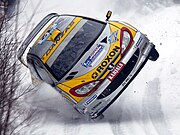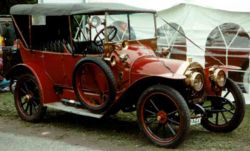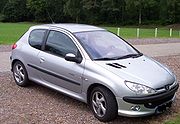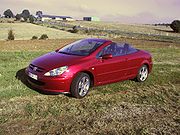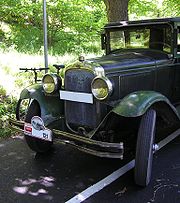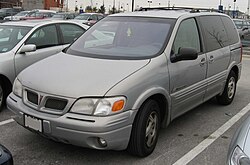Pre-war years: 1926-1942

1936 Pontiac Master Six Coupe
The Pontiac brand was introduced by General Motors in 1926 as the 'companion' marque to GM's Oakland Motor Car line. The Pontiac name was first used in 1906 by the Pontiac Spring & Wagon Works and linked to Chief Pontiac who led an unsuccessful uprising against the British shortly after the French and Indian War. The Oakland Motor Company and Pontiac Spring & Wagon Works Company merged in November 1908 under the name of the Oakland Motor Car Company. The operations of both companies were joined together in Pontiac, Michigan (in Oakland County) to build the Cartercar. Oakland was purchased by General Motors in 1909. The first General Motors Pontiac was conceived as an affordable six cylinder that was intended to compete with more inexpensive four cylinder models. Within months of its introduction, Pontiac outsold Oakland. As Pontiac's sales rose and Oakland's sales began to decline, Pontiac became the only 'companion' marque to survive its 'parent', in 1932.
Pontiac began selling cars with straight 6-cylinder engines. In 1933, it moved up to producing the cheapest cars with straight 8-cylinder engines. This was done by using many components from the 6-cylinder Chevrolet, such as the body. In the late 1930s, Pontiac used the so-called torpedo body of the Buick for one of its models just prior to its being used by Chevrolet as well. This body brought some attention to the marque.
For an extended period of time, prewar through the early 1950s, the Pontiac was a quiet and solid car, but not especially powerful. A flathead (side-valve) straight eight offered both the quietest and smoothest possible operation, with an appropriately soft suspension and quiet muffler offering the feeling of luxury without the expense. These combinations proved attractive to the vehicle's target market - a reserved lower middle class that was not especially interested in performance or handling and was seeking good value and a roomy vehicle in a step up from the entry-level Chevrolet. This fit well within parent GM's strategy of passing an increasingly prosperous customer up through the various divisions. Straight 8's are slightly less expensive to produce than the V8's that were growing in popularity, but they were also heavier and longer than a V8. Also, the long crankshaft suffered from excessive flex, which restricted straight 8's to relatively low compression and modest RPM's. In this application the inexpensive (but poorly-breathing) flat-head valves were not a liability.
[edit] Dowdy to Fun: 1946-1954

1948 Pontiac Silver Streak Convertible Coupe
Throughout this period, Pontiac models were seen as middle-of-the-road reliable cars more suited to middle income buyers of middle age. The emerging and lucrative younger, performance oriented customer eluded the brand. Although reliable cars, Pontiacs just couldn't shake their dowdy image.
From 1946-1948, all Pontiac models were essentially 1942 models with minor changes. The Hydra-matic automatic transmission was introduced in 1948 and helped Pontiac sales grow even though their cars, Torpedoes and Streamliners, were quickly becoming out of date and out of step with the growing youth market.
The first all-new Pontiac models appeared in 1949. Newly redesigned, they sported such styling cues as lower body lines and rear fenders that were integrated in the rear-end styling of the car.
Along with new styling came a new model. Continuing the Native American theme of Pontiac, the Chieftain line was introduced to replace the Torpedo. These were built on the GM B-Body platform and featured sportier styling than the more conservative Streamliner. In 1950, the Catalina trim-level was introduced as a sub-series.
In 1952, Pontiac discontinued the Streamliner and replaced it with additional models in the Chieftain line built on the GM A-body platform. This single model line continued until 1954 when the Star Chief was added. The Star Chief was created by adding an 11-inch (280 mm) extension to the A-body platform creating a 124-inch (3,100 mm) wheelbase.
The 1953 models were the first to have one-piece windshields instead of the normal two-piece units. While the 1953 and 1954 models were heavily re-worked versions of the 1949-52 Chieftain models, they were engineered to accommodate the V-8 engine that would appear in the all-new 1955 models.
[edit] Foundations of performance: 1955-1960
Although completely new bodies and chassis were introduced for 1955, the big news was the introduction of a new 173-horsepower (129 kW) overhead valve V-8 engine (see Engines section below). Pontiac took a big leap ahead in the public's eye and sales jumped accordingly. With the introduction of this V-8, the six cylinder engines were discontinued; a six-cylinder engine would not return to the full-size Pontiac line until the GM corporate downsizing of 1977.
The next step in Pontiac's transformation came in 1956 when Semon "Bunkie" Knudsen became general manager of Pontiac. With the aid of his new heads of engineering, E. M. Estes and John Z. De Lorean, he immediately began reworking the brand's image. One of the first steps involved the removal of the famous "silver streaks" from the hood and deck lid of the 1957 models just weeks before the '57s were introduced. Another step was introducing the first Bonneville--a limited-edition Star Chief convertible that showcased Pontiac's first fuel-injected engine. Some 630 Bonnevilles were built for 1957, each with a retail price of nearly $5800. While new car buyers could buy a Cadillac for that price, the Bonneville raised new interest in what Pontiac now called America's No. 1 Road Car.

1959
Bonneville from the rear, showing double rear fins
In the 1958 model year Knudsen saw to it that the car received a completely reworked chassis, body and interior styling. Quad headlamps, longer and lower bodys, honeycombed grilles and concave rear fender panels were some of the styling changes. Additionally the Bonneville, a sub-series of the Star Chief introduced in the 1957 models, became its own line. These were built on the 122-inch (3,100 mm) wheelbase of the A-body platform. An early sign of the successful changes being undertaken was seen in the selection of a 1958 Tri-Power Pontiac Bonneville the pace car for that year's Indianapolis 500.
For 1959, the Chieftain line was renamed Catalina; Star Chief was downgraded to replace the discontinued Super Chief series, and the Bonneville took over the Star Chief's four-door "Vista" hardtop and Custom Safari station wagon. This coincided with major body styling changes across all models that introduced increased glass area, twin V-shaped fins and lower hood profiles. Because of these changes, Motor Trend magazine picked the entire Pontiac line as 1959 Car of the Year. The '59s were also blessed with a five-inch (127 mm) wider track, because Knudsen noticed the new, wider bodies looked awkward on the carried-over 1958 frames. The new Wide-Track Pontiacs not only looked better, but also handled better--a bonus that tied in to Pontiac's resurgence in the marketplace.
The 1960 models saw a complete reskinning, which removed the tailfins and the distinctive split grille (which Ford copied on the final Edsel models for 1960!). More big news was the introduction of the Ventura, a more-luxurious hardtop coupe and Vista 4-door hardtop built on the shorter 122-inch (3,100 mm) wheelbase platform and falling between the Catalina and Star Chief models. The Ventura featured the luxury of the Bonneville in the shorter, lighter Catalina body, and started the Pontiac trend of increasing luxury in even its least expensive models.
[edit] The horsepower era: 1961-1970

1969 Pontiac GTO Convertible
The 1961 models were again drastically reworked. The split grille returned, as well as all-new bodies and a new-design perimeter frame chassis for all full-size models. These new chassis allowed for reduced weight and smaller body sizes.
The all new Tempest, while sharing its basic body with the Oldsmobile F-85 and the revived Buick Special "senior compacts," helped Pontiac win the Motor Trend "Car of the Year" award for the second time in three years in 1961.
The Tempest combined the B-O-P unibody design with the transaxle assembly used in the Corvair. GM had planned to launch a Pontiac version of the rear-engine Corvair for the 1961 model year, but "Bunkie" Knudsen--whose niece was seriously injured in a Corvair crash--successfully argued against the idea. Thus, the Tempest became America's only front-engine/rear transmission car, according to contemporary advertising.
The Tempest's engine--a 194.5 CID four-cylinder engine--was essentially the right bank of the Pontiac V-8, which enabled the car to be built on the same line as the full-size models from 1961 to 1963. A flexible steel driveshaft connected the engine and the transaxle. While this design did not prove durable in actual use, the early Tempests were the most popular of the GM senior compacts, and helped move Pontiac into third place among American car brands for 1962, a position Pontiac would hold though 1970. By 1964, the Tempest would spawn one of the biggest names of the muscle car era, the Gran Turismo Omologato; better known as the Pontiac GTO.
In 1961, Knudsen moved to Chevrolet and Estes took over as general manager. He continued Knudsens work of making Pontiac a performance car brand.
Although GM officially ended factory support for all racing activities across all of its brands in 1963, Pontiac continued to cater to performance car enthusiasts by making larger engines with more power available across all model lines. For instance, the small Tempest was equipped with a 326 cubic inch V-8 engine making 260 horsepower (190 kW). However, ordered with the LeMans GTO option, it came with a 389 cubic inch engine rated at 325 or 348 horsepower (260 kW), depending on carburetion.
In 1964, John Dee Lorean replaced Estes as general manager and he too continued Knudsen's work. It would be under his leadership that Pontiac charged headlong into the muscle car and pony car "wars" of the mid-to-late 1960s, offering a wide range of cars with solid performance credentials.
Due to the popularity of the GTO option, it was split from being an option on the Tempest LeMans series to become the separate GTO series. On the technology front, 1966 also saw the introduction of a completely new overhead camshaft 6-cylinder engine in the Tempest, and in an industry first, plastic grilles were used on the Grand Prix.
The 1967 model year saw the introduction the Pontiac Firebird pony car, a variant of the Chevrolet Camaro that was the brand's answer to the hot-selling Ford Mustang. 1968 introduced the Endura 'rubber' front bumper, the precursor to modern cars' integrated bumpers, and the first of a series of round port cylinder headed engines, the Ram Air II, available in the GTO and Firebird lines.
For 1969 the biggest changes were in the muscle car and pony car arenas. The GTO received the Ram Air option in its Judge package while the Firebird got a second Ram Air option called Ram Air IV and a special Trans Am package. This year also saw De Lorean leaving the post of general manager. His replacement was F. James McDonald.
[edit] Changed focus: 1970-1982
Although MacDonald tried to keep performance in the forefront of Pontiac's products, increasing insurance and fuel costs for owners coupled with looming Federal emissions and safety regulations would eventually put an end to the unrestricted, powerful engines of the 1960s. Safety, luxury and economy would become the new watch-words of this decade.
In trying to adjust to the changing market, in 1971 Pontiac introduced the compact, budget-priced Ventura II (based on the third generation Chevrolet Nova). This same year, Pontiac moved the Bonneville from its top of the line spot and replaced it with a higher luxury model named the Grand Ville.
The 1972 models saw the first wave of emissions reduction and safety equipment along with the standard round of updates. The impending demise of the muscle cars could be seen in the fact that once again the GTO was a sub-series of the LeMans series. Finally, the car that formed the foundation of the Pontiac muscle car line, the Tempest, was dropped, after being renamed 'T-37' and 'GT-37' for 1971.
MacDonald left the post of general manager to be replaced by Martin J. Caserio. Caserio was the first manager in over a decade to be more focused on marketing and sales than on performance.

1973 Pontiac
Grand Am, the first model year of the Grand Am
For 1973, Pontiac restyled its mid-sized LeMans and Ventura models and introduced the all-new Grand Am. All other models received only minor updates. Again, power dropped across all engines as more emissions requirements came into effect. The 1973 Firebird Trans Am saw the first introduction of the famous (or infamous depending on which automotive historian you talk to) large Firebird graphic. This factory applied decal, a John Schinella restylized interpretation of the Native American fire bird, took up most of the available space on the hood.
All Federal emissions and safety regulations were required to be in full effect for 1974 causing the demise of two of the three iterations of the big 455 cubic inch engines after this year. The last version of the 455 would hang on for two more years before being discontinued.
For 1975, Pontiac introduced the new sub-compact Astre, a version of the Chevrolet Vega. This was the brand's entry into the fuel economy segment of the market. 1975 would also see the end of Pontiac convertibles for the next decade.
The 1976 models were the last of the traditional American large cars with large engines. After this year, all GM models would go through "downsizing" and shrink in length, width, weight and available engine size. The Sunbird joined the line as a more sporty option to the conservative Astre.
For 1977, Pontiac replaced the Ventura with the Phoenix, a version of Chevrolet's fourth generation Nova. Pontiac also introduced its 151 cubic inch "Iron Duke" 4-cylinder overhead valve engine. This engine would later go into many GM and non-GM automobiles into the early 1990s. The Iron Duke and the 301 cubic inch V-8 were the last two engines designed solely by Pontiac. Subsequent engine design would be accomplished by one central office with all designs being shared by each brand.
The remainder of the 1970s and the early 1980s saw the continued rise of luxury, safety and economy as the key selling points in Pontiac products. Wire-spoked wheel covers returned for the first time since the 1930s. More station wagons than ever were being offered. Padded vinyl roofs were options on almost every model. Rear-wheel drive began its slow demise with the introduction of the first front-wheel drive Pontiac, the 1980 Phoenix (a version of the Chevrolet Citation). The Firebird continued to fly high on the success of the 'Smokey and the Bandit' film, still offering Formula and Trans Am packages, plus a Pontiac first- a turbocharged V-8. Overall, Pontiac's performance was a shadow of it's former self, but to give credit where due, PMD did more with less than most other brands were able to in this era.
[edit] Return of performance: 1982-1988
The beginning of Pontiacs second renaissance started with the vastly redesigned Firebird for the 1982 model year. The wedge shaped Firebird was the first major redesign of the venerable pony car since the early 1970s. It was an instant success and provided Pontiac with a foundation on which to build successively more performance oriented models over the next decade. The Trans Am also set a leading production aerodynamic mark of .32 cd.
The next step in Pontiac's resurgence came in the form of its first convertible in nine years. Seeing Chrysler's success with its K-Car-derived convertibles, GM decided it needed a competitor and quickly adapted the J-body cars. The all-new for 1983 2000 (later renamed Sunbird) had a convertible as part of its line.
Next came the 1984 Fiero. This was a major departure from anything Pontiac had produced in the past. A two-seat, mid-engined coupe, the Fiero was targeted straight at the same market that Semon Knudsen had been aiming for in the late 1950s: the young, affluent buyer who wanted sporting performance at a reasonable price. The Fiero was also an instant success and was partially responsible for Pontiac seeing its first increase in sales in four years.
Pontiac also began to focus on technology. In 1985, a Special Touring Edition (STE) was added to the 6000 line as a competitor to European road cars such as the Mercedes 190. The STE sported digital instruments and other electronics as well as a more powerful V-6 and retuned suspension. Later iterations would see some of the first introductions on Pontiacs of anti-lock brakes, steering wheel mounted radio controls and other advanced features.
With the exception of the Firebird and Fiero, beginning in 1988 all Pontiacs switched to front-wheel drive platforms. For the first time since 1972, Pontiac was the number three domestic car maker in America. Pontiac's drive to bring in more youthful buyers was working as the median age of Pontiac owners dropped from 46 in 1981 to 38 in 1988.
[edit] More of the same: 1989-1996
With the focus back on performance, Pontiac was once again doing what it did best. Although updating and revamping continued throughout the 1990s, the vast change seen during the 1980s did not. The period between 1989 and 1997 can best be described as one of continuous refinement. Anti-lock brakes, GM's Quad-4 engine, airbags and composite materials all became standard on Pontiacs during this time.
All new models were produced but at more lengthy intervals. The 1990 model year saw the launch of Pontiac's first minivan, the Trans Sport. An all-new Firebird debuted in 1993 while the Sunbird was replaced with the Sunfire in 1995.
[edit] Return to yesteryear: 1997-2004
Beginning in 1996, Pontiac began mining its historic past. The all new Grand Prix debuted with the Wide Track chassis making a return spearheaded by the "Wider is Better" advertising campaign. In 1998 Ram Air returned to the Trans Am. It would eventually make its way to the Grand Am.
The 1999 model year saw the replacement of the Trans Sport with the larger Montana minivan.
Faced with declining sales and a saturated sports car market, GM killed the Pontiac Firebird and its sister Chevrolet Camaro after the 2002 model year.
All other Pontiac models carried on until the end of the 2004 model year with only minor revisions and updates.
[edit] All change: 2005-present
For the 2005 model year, Pontiac embarked on a series of major changes not seen since the 1980s. Within four years, all of their cars would be replaced completely, both in design and name.
First to fall was the Bonneville which had no direct replacement. The same year, the Pontiac Grand Am was replaced with an all new model called the G6. The Sunfire was replaced with the G5 in the 2007 model year. Next in the line will be the G8; scheduled for the 2008 model year it will be a replacement for the Grand Prix and fill the void left by the Bonneville.
In an attempt to return Pontiac's focus to strictly performance oriented vehicles, the Montana was discontinued after the 2006 model year for the USA. Also for 2006, Pontiac fielded the unique Solstice roadster. Equipped with a pair of 4-cylinder engines, the Solstice is intended to compete with cars like the Mazda Miata, and the Honda S2000. GM's Saturn division came out with the Solstice's higher end twin, the Saturn Sky, the following model year. However, these attempts took a step backward with simultaneous release of the Torrent Crossover SUV. However, it is scheduled to be discontinued after the 2008 model year, marking Pontiac's exit out of the light truck market until the introduction of the Pontiac G8 ST in the fall of '08.

